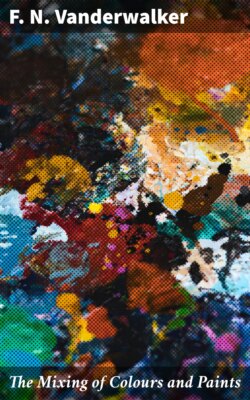Читать книгу The Mixing of Colours and Paints - F. N. Vanderwalker - Страница 5
CHAPTER I
COLOR AND LIGHT
ОглавлениеSunlight is the source of all color as well as of heat and light. With the setting sun all colors disappear from the earth. If it were not for artificial light our nights would be devoid of colors, relieved only by a contrast of moonlight and shadows.
Color is the property of light rays which causes visual action on the retina of the eye.
The Spectrum.—In the rainbow we see an array of colors. The image is called the sun spectrum. The spectrum is caused by the reflection of light rays from the sun. The same array of colors, or spectrum, you will notice when a ray of light passes through a raindrop or through a piece of three-sided plate glass, or a glass prism.
Prism.—A solid glass body of triangular shape.
A more formal definition of a spectrum is:—an image formed by rays of light passing through a glass prism in which the parts of light are arranged according to their wave lengths, forming a band displaying the colors of the rainbow. A beam of light from any source, such as the sun or ignited vapors (gas), passing through a glass prism is reflected and separated into colored light rays; these projected upon a surface constitute the spectrum. Red is red to the eye because it is composed of light ray vibrations of one wave length; blue is caused by a different wave length; yellow is vibrations of a still different wave length.
The array of colors called the spectrum is identically the same in character, and in the order of their arrangement, whether seen in the rainbow, a raindrop or a glass prism.
Primary Colors.—The strongest colors noted in the spectrum are red, blue and yellow. These are called the primary colors. In color theory all other colors are mixed from red, yellow and blue.
Secondary Colors.—Between these primary colors (red, blue, yellow) in the spectrum will be noticed violet, green and orange. These are called the secondary colors.
Intermediate Colors.—In the spectrum, again, between the primary colors and secondary colors there are six intermediate colors. They are violet-red, blue-violet, blue-green, yellow-green, orange-yellow, orange-red.
The order in which the colors of the spectrum are arranged is illustrated in Plate I.
In nature color is lavished in over a thousand (actually counted) delicate tints and shades on wild flowers, fish, birds, butterflies and other insects, or rocks, earth formations and elsewhere. And all of these colors are simply gradations of the primary, secondary and intermediate colors of the spectrum seen in the rainbow, the raindrop and the glass prism through light reflections.
Before passing on it is an excellent idea to study the spectrum. Since neither a rainbow nor a raindrop are likely to be handy when you want them, secure a glass prism or a piece of thick plate glass. Lay the glass flat on a desk or some dark surface in such away as to cause the direct rays of the sun to pass through the glass at an angle of about 45 degrees. It is easiest to do this with a late afternoon sun.
Plate 1.—Spectrum order of colors: Primary, Secondary and Intermediate Colors
When we come to the subjects of color mixing, color harmony and color use, later on in this book, more will be included about the practical use of primary, secondary and intermediate colors. So it is well for the student to keep these divisions of the spectrum in mind, and, particularly, that they are given to us through the laws of nature and the science of man. Man had nothing to do with the creation of the spectrum, but simply named it, classified its colors, and noted how they exist throughout the world.
It is interesting to note that objects do not possess colors of their own, but depend for color upon light reflected from their surface. By way of illustration, surfaces which are capable of reflecting all color rays appear red in red light, blue in blue light and white in daylight. In daylight all the color waves are present. Some surfaces are capable of absorbing all the light rays and reflect none;—these surfaces appear black, no matter what colored light falls upon them.
When part of all the light color rays is reflected and part absorbed, the surface appears gray.
In the case of leaves on plants, they appear green because they reflect green rays and absorb all other colored light rays. If, however, a leaf is taken out of the sunlight and flooded with red light it will appear black, because there are no green rays in the red light to be reflected by the leaf to the eye.
Flowers are red, yellow or blue, depending upon their ability to absorb some colors and reflect others;—that is true of all opaque objects.
In the case of transparent surfaces, they are colored by their ability to screen out certain light rays. Glass is red when only red rays pass through it. A glass or other surface which transmits all colors equally well, as does pure water in small amounts, is considered to be colorless.
